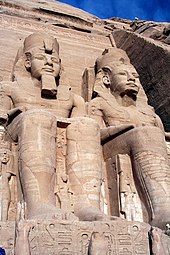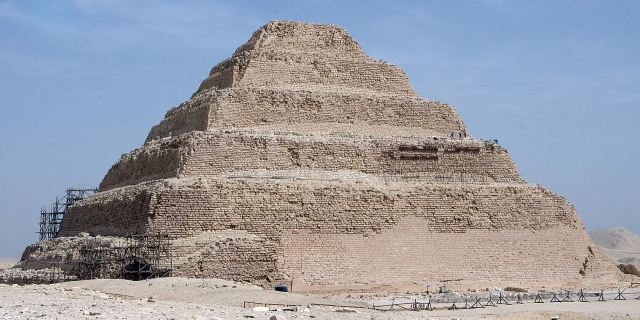Ancient Egypt
Context of Ancient Egypt
Ancient Egypt was a civilization in Northeast Africa situated in the Nile Valley. Ancient Egyptian civilization followed prehistoric Egypt and coalesced around 3100 BC (according to conventional Egyptian chronology) with the political unification of Upper and Lower Egypt under Menes (often identified with Narmer). The history of ancient Egypt occurred as a series of stable kingdoms, separated by periods of relative instability known as Intermediate Periods: the Old Kingdom of the Early Bronze Age, the Middle Kingdom of the Middle Bronze Age and the New Kingdom of the Late Bronze Age.
Egypt reached the pinnacle of its power in the New Kingdom, ruling much of Nubia and a sizable ...Read more
Ancient Egypt was a civilization in Northeast Africa situated in the Nile Valley. Ancient Egyptian civilization followed prehistoric Egypt and coalesced around 3100 BC (according to conventional Egyptian chronology) with the political unification of Upper and Lower Egypt under Menes (often identified with Narmer). The history of ancient Egypt occurred as a series of stable kingdoms, separated by periods of relative instability known as Intermediate Periods: the Old Kingdom of the Early Bronze Age, the Middle Kingdom of the Middle Bronze Age and the New Kingdom of the Late Bronze Age.
Egypt reached the pinnacle of its power in the New Kingdom, ruling much of Nubia and a sizable portion of the Levant, after which it entered a period of slow decline. During the course of its history, Egypt was invaded or conquered by a number of foreign powers, including the Hyksos, the Libyans, the Nubians, the Assyrians, the Achaemenid Persians, and the Macedonians under Alexander the Great. The Greek Ptolemaic Kingdom, formed in the aftermath of Alexander's death, ruled Egypt until 30 BC, when, under Cleopatra, it fell to the Roman Empire and became a Roman province.
The success of ancient Egyptian civilization came partly from its ability to adapt to the conditions of the Nile River valley for agriculture. The predictable flooding and controlled irrigation of the fertile valley produced surplus crops, which supported a more dense population, and social development and culture. With resources to spare, the administration sponsored mineral exploitation of the valley and surrounding desert regions, the early development of an independent writing system, the organization of collective construction and agricultural projects, trade with surrounding regions, and a military intended to assert Egyptian dominance. Motivating and organizing these activities was a bureaucracy of elite scribes, religious leaders, and administrators under the control of a pharaoh, who ensured the cooperation and unity of the Egyptian people in the context of an elaborate system of religious beliefs.
The many achievements of the ancient Egyptians include the quarrying, surveying, and construction techniques that supported the building of monumental pyramids, temples, and obelisks; a system of mathematics, a practical and effective system of medicine, irrigation systems, and agricultural production techniques, the first known planked boats, Egyptian faience and glass technology, new forms of literature, and the earliest known peace treaty, made with the Hittites. Ancient Egypt has left a lasting legacy. Its art and architecture were widely copied, and its antiquities were carried off to far corners of the world. Its monumental ruins have inspired the imaginations of travelers and writers for millennia. A newfound respect for antiquities and excavations in the early modern period by Europeans and Egyptians has led to the scientific investigation of Egyptian civilization and a greater appreciation of its cultural legacy.
More about Ancient Egypt
The Nile has been the lifeline of its region for much of human history.[1] The fertile floodplain of the Nile gave humans the opportunity to develop a settled agricultural economy and a more sophisticated, centralized society that became a cornerstone in the history of human civilization.[2] Nomadic modern human hunter-gatherers began living in the Nile valley through the end of the Middle Pleistocene some 120,000 years ago. By the late Paleolithic period, the arid climate of Northern Africa had become increasingly hot and dry, forcing the populations of the area to concentrate along the river region.
...Read moreRead lessThe Nile has been the lifeline of its region for much of human history.[1] The fertile floodplain of the Nile gave humans the opportunity to develop a settled agricultural economy and a more sophisticated, centralized society that became a cornerstone in the history of human civilization.[2] Nomadic modern human hunter-gatherers began living in the Nile valley through the end of the Middle Pleistocene some 120,000 years ago. By the late Paleolithic period, the arid climate of Northern Africa had become increasingly hot and dry, forcing the populations of the area to concentrate along the river region.
Predynastic period
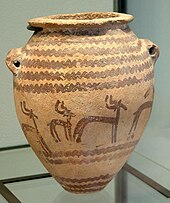 A typical Naqada II jar decorated with gazelles (Predynastic Period)
A typical Naqada II jar decorated with gazelles (Predynastic Period)In Predynastic and Early Dynastic times, the Egyptian climate was much less arid than it is today. Large regions of Egypt were covered in treed savanna and traversed by herds of grazing ungulates. Foliage and fauna were far more prolific in all environs, and the Nile region supported large populations of waterfowl. Hunting would have been common for Egyptians, and this is also the period when many animals were first domesticated.[3]
By about 5500 BC, small tribes living in the Nile valley had developed into a series of cultures demonstrating firm control of agriculture and animal husbandry, and identifiable by their pottery and personal items, such as combs, bracelets, and beads. The largest of these early cultures in upper (Southern) Egypt was the Badarian culture, which probably originated in the Western Desert; it was known for its high-quality ceramics, stone tools, and its use of copper.[4]
 Early tomb painting from Nekhen, c. 3500 BC, Naqada, possibly Gerzeh, culture
Early tomb painting from Nekhen, c. 3500 BC, Naqada, possibly Gerzeh, cultureThe Badari was followed by the Naqada culture: the Amratian (Naqada I), the Gerzeh (Naqada II), and Semainean (Naqada III).[5][page needed] These brought a number of technological improvements. As early as the Naqada I Period, predynastic Egyptians imported obsidian from Ethiopia, used to shape blades and other objects from flakes.[6] In Naqada II times, early evidence exists of contact with the Near East, particularly Canaan and the Byblos coast.[7] Over a period of about 1,000 years, the Naqada culture developed from a few small farming communities into a powerful civilization whose leaders were in complete control of the people and resources of the Nile valley.[8] Establishing a power center at Nekhen (in Greek, Hierakonpolis), and later at Abydos, Naqada III leaders expanded their control of Egypt northwards along the Nile.[9] They also traded with Nubia to the south, the oases of the western desert to the west, and the cultures of the eastern Mediterranean and Near East to the east, initiating a period of Egypt-Mesopotamia relations.[10][when?]
The Naqada culture manufactured a diverse selection of material goods, reflective of the increasing power and wealth of the elite, as well as societal personal-use items, which included combs, small statuary, painted pottery, high quality decorative stone vases, cosmetic palettes, and jewelry made of gold, lapis, and ivory. They also developed a ceramic glaze known as faience, which was used well into the Roman Period to decorate cups, amulets, and figurines.[11] During the last predynastic phase, the Naqada culture began using written symbols that eventually were developed into a full system of hieroglyphs for writing the ancient Egyptian language.[12]
Early Dynastic Period (c. 3150–2686 BC)The Early Dynastic Period was approximately contemporary to the early Sumerian-Akkadian civilization of Mesopotamia and of ancient Elam. The third-century BC Egyptian priest Manetho grouped the long line of kings from Menes to his own time into 30 dynasties, a system still used today. He began his official history with the king named "Meni" (or Menes in Greek), who was believed to have united the two kingdoms of Upper and Lower Egypt.[13]
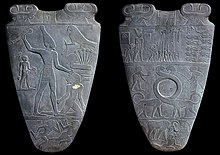 The Narmer Palette depicts the unification of the Two Lands.[14]
The Narmer Palette depicts the unification of the Two Lands.[14]The transition to a unified state happened more gradually than ancient Egyptian writers represented, and there is no contemporary record of Menes. Some scholars now believe, however, that the mythical Menes may have been the king Narmer, who is depicted wearing royal regalia on the ceremonial Narmer Palette, in a symbolic act of unification.[15] In the Early Dynastic Period, which began about 3000 BC, the first of the Dynastic kings solidified control over lower Egypt by establishing a capital at Memphis, from which he could control the labour force and agriculture of the fertile delta region, as well as the lucrative and critical trade routes to the Levant. The increasing power and wealth of the kings during the early dynastic period was reflected in their elaborate mastaba tombs and mortuary cult structures at Abydos, which were used to celebrate the deified king after his death.[16] The strong institution of kingship developed by the kings served to legitimize state control over the land, labour, and resources that were essential to the survival and growth of ancient Egyptian civilization.[17]
Old Kingdom (2686–2181 BC)Major advances in architecture, art, and technology were made during the Old Kingdom, fueled by the increased agricultural productivity and resulting population, made possible by a well-developed central administration.[18] Some of ancient Egypt's crowning achievements, the Giza pyramids and Great Sphinx, were constructed during the Old Kingdom. Under the direction of the vizier, state officials collected taxes, coordinated irrigation projects to improve crop yield, drafted peasants to work on construction projects, and established a justice system to maintain peace and order.[19]
 Khafre enthroned
Khafre enthronedWith the rising importance of central administration in Egypt, a new class of educated scribes and officials arose who were granted estates by the king in payment for their services. Kings also made land grants to their mortuary cults and local temples, to ensure that these institutions had the resources to worship the king after his death. Scholars believe that five centuries of these practices slowly eroded the economic vitality of Egypt, and that the economy could no longer afford to support a large centralized administration.[20] As the power of the kings diminished, regional governors called nomarchs began to challenge the supremacy of the office of king. This, coupled with severe droughts between 2200 and 2150 BC,[21] is believed to have caused the country to enter the 140-year period of famine and strife known as the First Intermediate Period.[22]
First Intermediate Period (2181–2055 BC)After Egypt's central government collapsed at the end of the Old Kingdom, the administration could no longer support or stabilize the country's economy. Regional governors could not rely on the king for help in times of crisis, and the ensuing food shortages and political disputes escalated into famines and small-scale civil wars. Yet despite difficult problems, local leaders, owing no tribute to the king, used their new-found independence to establish a thriving culture in the provinces. Once in control of their own resources, the provinces became economically richer—which was demonstrated by larger and better burials among all social classes.[23] In bursts of creativity, provincial artisans adopted and adapted cultural motifs formerly restricted to the royalty of the Old Kingdom, and scribes developed literary styles that expressed the optimism and originality of the period.[24]
Free from their loyalties to the king, local rulers began competing with each other for territorial control and political power. By 2160 BC, rulers in Herakleopolis controlled Lower Egypt in the north, while a rival clan based in Thebes, the Intef family, took control of Upper Egypt in the south. As the Intefs grew in power and expanded their control northward, a clash between the two rival dynasties became inevitable. Around 2055 BC the northern Theban forces under Nebhepetre Mentuhotep II finally defeated the Herakleopolitan rulers, reuniting the Two Lands. They inaugurated a period of economic and cultural renaissance known as the Middle Kingdom.[25]
Middle Kingdom (2134–1690 BC)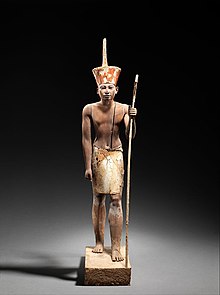 A figure wearing the red crown of Lower Egypt and whose face appears to reflect the features of the reigning king, most probably Amenemhat II or Senwosret II. It functioned as a divine guardian for the imiut, and it is wearing a divine kilt, which suggests that the statuette was not merely a representation of the living ruler.[26]
A figure wearing the red crown of Lower Egypt and whose face appears to reflect the features of the reigning king, most probably Amenemhat II or Senwosret II. It functioned as a divine guardian for the imiut, and it is wearing a divine kilt, which suggests that the statuette was not merely a representation of the living ruler.[26] Amenemhat III, the last great ruler of the Middle Kingdom
Amenemhat III, the last great ruler of the Middle KingdomThe kings of the Middle Kingdom restored the country's stability and prosperity, thereby stimulating a resurgence of art, literature, and monumental building projects.[27] Mentuhotep II and his Eleventh Dynasty successors ruled from Thebes, but the vizier Amenemhat I, upon assuming the kingship at the beginning of the Twelfth Dynasty around 1985 BC, shifted the kingdom's capital to the city of Itjtawy, located in Faiyum.[28] From Itjtawy, the kings of the Twelfth Dynasty undertook a far-sighted land reclamation and irrigation scheme to increase agricultural output in the region. Moreover, the military reconquered territory in Nubia that was rich in quarries and gold mines, while laborers built a defensive structure in the Eastern Delta, called the "Walls of the Ruler", to defend against foreign attack.[29]
With the kings having secured the country militarily and politically and with vast agricultural and mineral wealth at their disposal, the nation's population, arts, and religion flourished. In contrast to elitist Old Kingdom attitudes towards the gods, the Middle Kingdom displayed an increase in expressions of personal piety.[30] Middle Kingdom literature featured sophisticated themes and characters written in a confident, eloquent style.[24] The relief and portrait sculpture of the period captured subtle, individual details that reached new heights of technical sophistication.[31]
The last great ruler of the Middle Kingdom, Amenemhat III, allowed Semitic-speaking Canaanite settlers from the Near East into the Delta region to provide a sufficient labour force for his especially active mining and building campaigns. These ambitious building and mining activities, however, combined with severe Nile floods later in his reign, strained the economy and precipitated the slow decline into the Second Intermediate Period during the later Thirteenth and Fourteenth dynasties. During this decline, the Canaanite settlers began to assume greater control of the Delta region, eventually coming to power in Egypt as the Hyksos.[32]
Second Intermediate Period (1674–1549 BC) and the HyksosAround 1785 BC, as the power of the Middle Kingdom kings weakened, a Western Asian people called the Hyksos, who had already settled in the Delta, seized control of Egypt and established their capital at Avaris, forcing the former central government to retreat to Thebes. The king was treated as a vassal and expected to pay tribute.[33] The Hyksos ("foreign rulers") retained Egyptian models of government and identified as kings, thereby integrating Egyptian elements into their culture. They and other invaders introduced new tools of warfare into Egypt, most notably the composite bow and the horse-drawn chariot.[34]
After retreating south, the native Theban kings found themselves trapped between the Canaanite Hyksos ruling the north and the Hyksos' Nubian allies, the Kushites, to the south. After years of vassalage, Thebes gathered enough strength to challenge the Hyksos in a conflict that lasted more than 30 years, until 1555 BC.[33] The kings Seqenenre Tao II and Kamose were ultimately able to defeat the Nubians to the south of Egypt, but failed to defeat the Hyksos. That task fell to Kamose's successor, Ahmose I, who successfully waged a series of campaigns that permanently eradicated the Hyksos' presence in Egypt. He established a new dynasty and, in the New Kingdom that followed, the military became a central priority for the kings, who sought to expand Egypt's borders and attempted to gain mastery of the Near East.[35]
New Kingdom (1549–1069 BC) Pharaohs' tombs were provided with vast quantities of wealth, such as the golden mask from the mummy of Tutankhamun.
Pharaohs' tombs were provided with vast quantities of wealth, such as the golden mask from the mummy of Tutankhamun.The New Kingdom pharaohs established a period of unprecedented prosperity by securing their borders and strengthening diplomatic ties with their neighbours, including the Mitanni Empire, Assyria, and Canaan. Military campaigns waged under Tuthmosis I and his grandson Tuthmosis III extended the influence of the pharaohs to the largest empire Egypt had ever seen. Beginning with Merneptah the rulers of Egypt adopted the title of pharaoh.
Between their reigns, Hatshepsut, a queen who established herself as pharaoh, launched many building projects, including the restoration of temples damaged by the Hyksos, and sent trading expeditions to Punt and the Sinai.[36] When Tuthmosis III died in 1425 BC, Egypt had an empire extending from Niya in north west Syria to the Fourth Cataract of the Nile in Nubia, cementing loyalties and opening access to critical imports such as bronze and wood.[37]
The New Kingdom pharaohs began a large-scale building campaign to promote the god Amun, whose growing cult was based in Karnak. They also constructed monuments to glorify their own achievements, both real and imagined. The Karnak temple is the largest Egyptian temple ever built.[38]
Around 1350 BC, the stability of the New Kingdom was threatened when Amenhotep IV ascended the throne and instituted a series of radical and chaotic reforms. Changing his name to Akhenaten, he touted the previously obscure sun deity Aten as the supreme deity, suppressed the worship of most other deities, and moved the capital to the new city of Akhetaten (modern-day Amarna).[39] He was devoted to his new religion and artistic style. After his death, the cult of the Aten was quickly abandoned and the traditional religious order restored. The subsequent pharaohs, Tutankhamun, Ay, and Horemheb, worked to erase all mention of Akhenaten's heresy, now known as the Amarna Period.[40]
Four colossal statues of Ramesses II flank the entrance of his temple Abu SimbelAround 1279 BC, Ramesses II, also known as Ramesses the Great, ascended the throne, and went on to build more temples, erect more statues and obelisks, and sire more children than any other pharaoh in history.[a] A bold military leader, Ramesses II led his army against the Hittites in the Battle of Kadesh (in modern Syria) and, after fighting to a stalemate, finally agreed to the first recorded peace treaty, around 1258 BC.[41]
Egypt's wealth, however, made it a tempting target for invasion, particularly by the Libyan Berbers to the west, and the Sea Peoples, a conjectured confederation of seafarers from the Aegean Sea.[b] Initially, the military was able to repel these invasions, but Egypt eventually lost control of its remaining territories in southern Canaan, much of it falling to the Assyrians. The effects of external threats were exacerbated by internal problems such as corruption, tomb robbery, and civil unrest. After regaining their power, the high priests at the temple of Amun in Thebes accumulated vast tracts of land and wealth, and their expanded power splintered the country during the Third Intermediate Period.[42]
Third Intermediate Period (1069–653 BC)Following the death of Ramesses XI in 1078 BC, Smendes assumed authority over the northern part of Egypt, ruling from the city of Tanis. The south was effectively controlled by the High Priests of Amun at Thebes, who recognized Smendes in name only.[43] During this time, Libyans had been settling in the western delta, and chieftains of these settlers began increasing their autonomy. Libyan princes took control of the delta under Shoshenq I in 945 BC, founding the so-called Libyan or Bubastite dynasty that would rule for some 200 years. Shoshenq also gained control of southern Egypt by placing his family members in important priestly positions. Libyan control began to erode as a rival dynasty in the delta arose in Leontopolis, and Kushites threatened from the south.
 Statues of two pharaohs of Egypt's Twenty-Fifth Dynasty and several other Kushite kings. From left to right: Tantamani, Taharqa (rear), Senkamanisken, again Tantamani (rear), Aspelta, Anlamani, again Senkamanisken. Kerma Museum.[44]
Statues of two pharaohs of Egypt's Twenty-Fifth Dynasty and several other Kushite kings. From left to right: Tantamani, Taharqa (rear), Senkamanisken, again Tantamani (rear), Aspelta, Anlamani, again Senkamanisken. Kerma Museum.[44]Around 727 BC the Kushite king Piye invaded northward, seizing control of Thebes and eventually the Delta, which established the 25th Dynasty.[45] During the 25th Dynasty, Pharaoh Taharqa created an empire nearly as large as the New Kingdom's. Twenty-fifth Dynasty pharaohs built, or restored, temples and monuments throughout the Nile valley, including at Memphis, Karnak, Kawa, and Jebel Barkal.[46] During this period, the Nile valley saw the first widespread construction of pyramids (many in modern Sudan) since the Middle Kingdom.[47][48][49]
 Assyrian siege of an Egyptian fortified city, a scene from the Assyrian conquest of Egypt, probably referring to the capture of Memphis in 667 BC. Sculpted in 645–635 BC, under Ashurbanipal. British Museum.[50]
Assyrian siege of an Egyptian fortified city, a scene from the Assyrian conquest of Egypt, probably referring to the capture of Memphis in 667 BC. Sculpted in 645–635 BC, under Ashurbanipal. British Museum.[50]Egypt's far-reaching prestige declined considerably toward the end of the Third Intermediate Period. Its foreign allies had fallen under the Assyrian sphere of influence, and by 700 BC war between the two states became inevitable. Between 671 and 667 BC the Assyrians began the Assyrian conquest of Egypt. The reigns of both Taharqa and his successor, Tanutamun, were filled with constant conflict with the Assyrians, against whom Egypt enjoyed several victories. Ultimately, the Assyrians pushed the Kushites back into Nubia, occupied Memphis, and sacked the temples of Thebes.[51]
Late Period (653–332 BC)The Assyrians left control of Egypt to a series of vassals who became known as the Saite kings of the Twenty-Sixth Dynasty. By 653 BC, the Saite king Psamtik I was able to oust the Assyrians with the help of Greek mercenaries, who were recruited to form Egypt's first navy. Greek influence expanded greatly as the city-state of Naucratis became the home of Greeks in the Nile Delta. The Saite kings based in the new capital of Sais witnessed a brief but spirited resurgence in the economy and culture, but in 525 BC, the powerful Persians, led by Cambyses II, began their conquest of Egypt, eventually capturing the pharaoh Psamtik III at the Battle of Pelusium. Cambyses II then assumed the formal title of pharaoh, but ruled Egypt from Iran, leaving Egypt under the control of a satrap. A few successful revolts against the Persians marked the 5th century BC, but Egypt was never able to permanently overthrow the Persians.[52]
Following its annexation by Persia, Egypt was joined with Cyprus and Phoenicia in the sixth satrapy of the Achaemenid Persian Empire. This first period of Persian rule over Egypt, also known as the Twenty-Seventh Dynasty, ended in 402 BC, when Egypt regained independence under a series of native dynasties. The last of these dynasties, the Thirtieth, proved to be the last native royal house of ancient Egypt, ending with the kingship of Nectanebo II. A brief restoration of Persian rule, sometimes known as the Thirty-First Dynasty, began in 343 BC, but shortly after, in 332 BC, the Persian ruler Mazaces handed Egypt over to Alexander the Great without a fight.[53]
Ptolemaic period (332–30 BC) Portrait of Ptolemy VI Philometor wearing the double crown of Egypt
Portrait of Ptolemy VI Philometor wearing the double crown of EgyptIn 332 BC, Alexander the Great conquered Egypt with little resistance from the Persians and was welcomed by the Egyptians as a deliverer. The administration established by Alexander's successors, the Macedonian Ptolemaic Kingdom, was based on an Egyptian model and based in the new capital city of Alexandria. The city showcased the power and prestige of Hellenistic rule, and became a seat of learning and culture, centered at the famous Library of Alexandria.[54] The Lighthouse of Alexandria lit the way for the many ships that kept trade flowing through the city—as the Ptolemies made commerce and revenue-generating enterprises, such as papyrus manufacturing, their top priority.[55]
Hellenistic culture did not supplant native Egyptian culture, as the Ptolemies supported time-honored traditions in an effort to secure the loyalty of the populace. They built new temples in Egyptian style, supported traditional cults, and portrayed themselves as pharaohs. Some traditions merged, as Greek and Egyptian gods were syncretized into composite deities, such as Serapis, and classical Greek forms of sculpture influenced traditional Egyptian motifs. Despite their efforts to appease the Egyptians, the Ptolemies were challenged by native rebellion, bitter family rivalries, and the powerful mob of Alexandria that formed after the death of Ptolemy IV.[56] In addition, as Rome relied more heavily on imports of grain from Egypt, the Romans took great interest in the political situation in the country. Continued Egyptian revolts, ambitious politicians, and powerful opponents from the Near East made this situation unstable, leading Rome to send forces to secure the country as a province of its empire.[57]
Roman period (30 BC – AD 641)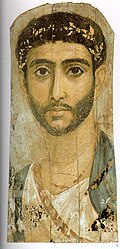 The Fayum mummy portraits epitomize the meeting of Egyptian and Roman cultures.
The Fayum mummy portraits epitomize the meeting of Egyptian and Roman cultures. Copper-alloy statuettes of Egyptian gods Anubis (left) and Horus (centre) as Roman officers with contrapposto stances (National Archaeological Museum, Athens)
Copper-alloy statuettes of Egyptian gods Anubis (left) and Horus (centre) as Roman officers with contrapposto stances (National Archaeological Museum, Athens)Egypt became a province of the Roman Empire in 30 BC, following the defeat of Mark Antony and Ptolemaic Queen Cleopatra VII by Octavian (later Emperor Augustus) in the Battle of Actium. The Romans relied heavily on grain shipments from Egypt, and the Roman army, under the control of a prefect appointed by the emperor, quelled rebellions, strictly enforced the collection of heavy taxes, and prevented attacks by bandits, which had become a notorious problem during the period.[58] Alexandria became an increasingly important center on the trade route with the orient, as exotic luxuries were in high demand in Rome.[59]
Although the Romans had a more hostile attitude than the Greeks towards the Egyptians, some traditions such as mummification and worship of the traditional gods continued.[60] The art of mummy portraiture flourished, and some Roman emperors had themselves depicted as pharaohs, though not to the extent that the Ptolemies had. The former lived outside Egypt and did not perform the ceremonial functions of Egyptian kingship. Local administration became Roman in style and closed to native Egyptians.[60]
From the mid-first century AD, Christianity took root in Egypt and it was originally seen as another cult that could be accepted. However, it was an uncompromising religion that sought to win converts from the pagan Egyptian and Greco-Roman religions and threatened popular religious traditions. This led to the persecution of converts to Christianity, culminating in the great purges of Diocletian starting in 303, but eventually Christianity won out.[61] In 391, the Christian emperor Theodosius introduced legislation that banned pagan rites and closed temples.[62] Alexandria became the scene of great anti-pagan riots with public and private religious imagery destroyed.[63] As a consequence, Egypt's native religious culture was continually in decline. While the native population continued to speak their language, the ability to read hieroglyphic writing slowly disappeared as the role of the Egyptian temple priests and priestesses diminished. The temples themselves were sometimes converted to churches or abandoned to the desert.[64]
In the fourth century, as the Roman Empire divided, Egypt found itself in the Eastern Empire with its capital at Constantinople. In the waning years of the Empire, Egypt fell to the Sasanian Persian army in the Sasanian conquest of Egypt (618–628). It was then recaptured by the Byzantine emperor Heraclius (629–639), and was finally captured by Muslim Rashidun army in 639–641, ending Byzantine rule.
^ Shaw (2003), pp. 17, 67–69. ^ Shaw (2003), p. 17. ^ Ikram (1992), p. 5. ^ Hayes (1964), p. 220. ^ Childe (2014). ^ Aston, Barbara G.; Harrell, James A.; Shaw, Ian. Stone: Obsidian. pp. 46–47. in Nicholson & Shaw (2000)
• Aston (1994), pp. 23–26
• "Obsidian". Digital Egypt for Universities. University College London. 2002. Archived from the original on 1 June 2013. Retrieved 11 February 2022.
• "The origin of obsidian used in the Naqada Period in Egypt". Digital Egypt for Universities. University College London. 2000. Archived from the original on 31 May 2013. Retrieved 11 February 2022. ^ Patai (1998). ^ "Chronology of the Naqada Period". Digital Egypt for Universities. University College London. 2001. Archived from the original on 28 March 2008. ^ Shaw (2003), p. 61. ^ Shaw (2003), p. 61; Hartwig (2014), pp. 424–425. ^ "Faience in different Periods". Digital Egypt for Universities. University College London. 2000. Archived from the original on 30 March 2008. ^ Allen (2000), p. 1. ^ Clayton (1994), p. 6. ^ Robins (2008), p. 32. ^ Clayton (1994), pp. 12–13. ^ Shaw (2003), p. 70. ^ "Early Dynastic Egypt". Digital Egypt for Universities. University College London. 2001. Archived from the original on 4 March 2008. ^ James (2005), p. 40. ^ Shaw (2003), p. 102. ^ Shaw (2003), pp. 116–117. ^ Hassan, Fekri (17 February 2011). "The Fall of the Old Kingdom". BBC. ^ Clayton (1994), p. 69. ^ Shaw (2003), p. 120. ^ a b Shaw (2003), p. 146. ^ Clayton (1994), p. 29. ^ "Guardian Figure". www.metmuseum.org. Metropolitan Museum of Art. Retrieved 9 February 2022. ^ Shaw (2003), p. 148. ^ Clayton (1994), p. 79. ^ Shaw (2003), p. 158. ^ Shaw (2003), pp. 179–182. ^ Robins (2008), p. 90. ^ Shaw (2003), p. 188. ^ a b Ryholt (1997), p. 310. ^ Shaw (2003), p. 189. ^ Shaw (2003), p. 224. ^ Clayton (1994), pp. 104–107. ^ James (2005), p. 48. ^ Bleiberg (2005). ^ Aldred (1988), p. 259. ^ O'Connor & Cline (2001), p. 273. ^ Tyldesley (2001), pp. 76–77. ^ James (2005), p. 54. ^ Cerny (1975), p. 645. ^ Bonnet, Charles (2006). The Nubian pharaohs : Black kings on the Nile. Dominique Valbelle. Cairo: American University in Cairo Press. p. 128. ISBN 977-416-010-X. OCLC 85370695. ^ Shaw (2003), p. 345. ^ Bonnet, Charles (2006). The Nubian Pharaohs. New York: The American University in Cairo Press. pp. 142–154. ISBN 978-977-416-010-3. ^ Mokhtar, G. (1990). General History of Africa. California, USA: University of California Press. pp. 161–163. ISBN 978-0-520-06697-7. ^ Emberling, Geoff (2011). Nubia: Ancient Kingdoms of Africa. New York: Institute for the Study of the Ancient World. pp. 9–11. ISBN 978-0-615-48102-9. ^ Silverman, David (1997). Ancient Egypt. New York: Oxford University Press. pp. 36–37. ISBN 978-0-19-521270-9. ^ "Wall panel; relief British Museum". The British Museum. ^ Shaw (2003), p. 358. ^ Shaw (2003), p. 383. ^ Shaw (2003), p. 385. ^ Shaw (2003), p. 405. ^ Shaw (2003), p. 411. ^ Shaw (2003), p. 418. ^ James (2005), p. 62. ^ James (2005), p. 63. ^ Shaw (2003), p. 426. ^ a b Shaw (2003), p. 422. ^ Shaw (2003), p. 431. ^ Chadwick (2001), p. 373. ^ MacMullen (1984), p. 63. ^ Shaw (2003), p. 445.
Cite error: There are <ref group=lower-alpha> tags or {{efn}} templates on this page, but the references will not show without a {{reflist|group=lower-alpha}} template or {{notelist}} template (see the help page).








